Enabled reports operate on a predetermined weekly or monthly schedule, requiring no further action from a user. In contrast, disabled reports do not run automatically according to a schedule. However, a disabled report can be executed on an ad-hoc basis from the Report Management page at any time.
This document provides an overview of the File IQ reports, including their individual configuration settings and instructions for restoring them to their default settings.
Enable All Reports
Note: The Enable All Reports feature is only available in File IQ version 10.2+
The Enable All Reports functionality allows you to automatically enable and configure all reports with a single click. When enabling this feature, the following actions take place:
Each report executes according to its scheduled time.
All connected volumes are selected for every Volume Metadata report.
For the Volume Usage Detail Report, the root of each volume is configured for every connected volume.
To configure Reporting using the Enable All functionality, follow these steps:
Navigate to the File IQ UI.
Click Configuration > Reports.
Click Enable All.
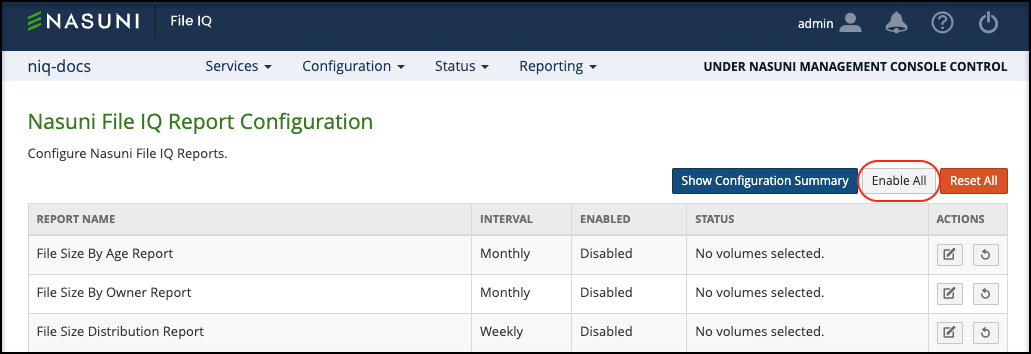
In the Confirmation Phrase field, enter “Enable All Reports“.
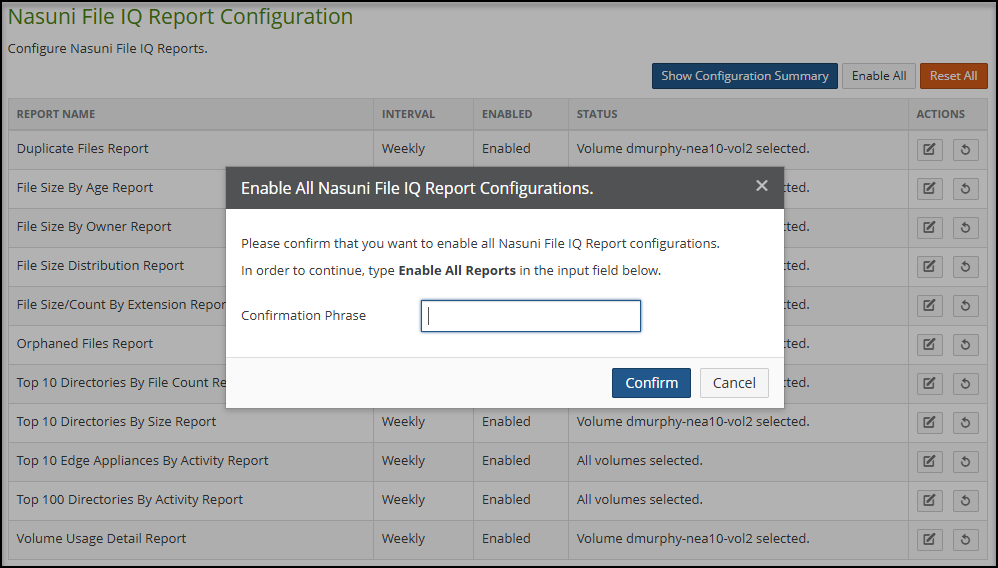
Click Confirm.
Note: The Orphaned Files Report is not enabled as part of this capability as the recommendation is to run this report manually.
Report Configuration Summary
Note: The Report Configuration Summary feature is only available in File IQ version 10.2+
The Report Configuration Summary lets you explore the configured volumes for all reports in a single view.
The summary provides:
One row per report and volume selection.
The configured paths per volume for the Volume Usage Detail Report.
Pagination, in addition to filtering by report and volume name.
Note: Volumes not configured in a report do not appear in the summary view.
To view the Report Configuration Summary, follow these steps:
Navigate to the File IQ UI.
Click Configuration > Reports.
Click Show Configuration Summary.
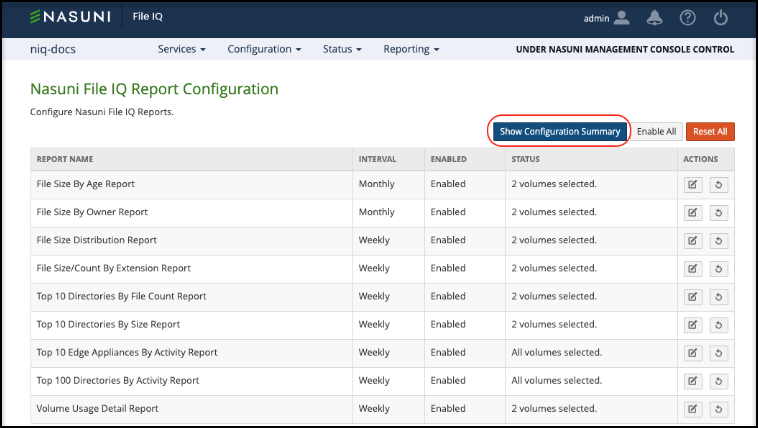
(Optional) Click Download CSV to download the filtered configuration summary as a CSV file.
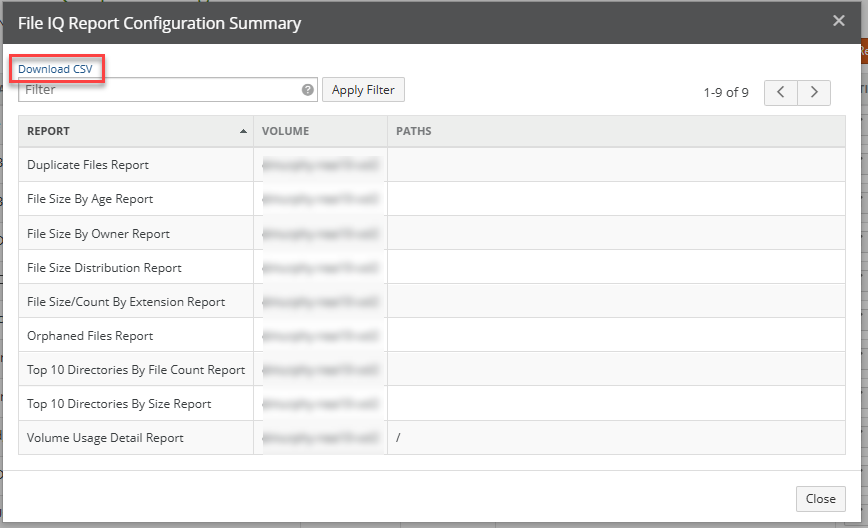
Troubleshooting the Report Configuration Summary
Q: I clicked Enable All, but one or more volumes are not selected for any given Report.
A: Verify that the File IQ Appliance already recognizes the volumes, and that any Volumes appear in the Volumes Summary Grafana dashboard.
Q: I clicked Enable All, but no volumes are selected for Top 10 Edge Appliances By Activity Report or Top 100 Directories By Activity Report.
A: Volume selection is not required for Volume Activity reports. Volume selection applies to Volume Metadata reports only.
Q: The Report Configuration Summary view does not list a volume Metadata Report.
A: The summary view contains entries for each report and volume selection. When no Volumes are selected for a given report, it does not appear in the view.
Q: The Report Configuration Summary view does not list any Volume Activity Reports.
A: The summary view does not display information about Volume Activity reports.
Volume Usage Detail Report
The Volume Usage Detail report allows the File IQ Administrator to specify arbitrary volume and directory pairs, including their immediate subdirectories, for volume usage detail reporting.
This report is executed weekly in PDF and CSV formats.
The PDF format includes the following information for each volume:
The set of directories selected by the report configuration.
For each configured directory:
The total size of the directory and the percentage of total volume usage it represents.
The total number of files within the directory and the percentage of all volume files it contains.
The total number of subdirectories within the directory and the percentage of all directories for this volume.
For every configured directory with children selected:
Every immediate subdirectory. For each subdirectory:
The total size of the directory and the percentage of total volume usage it represents.
The total number of files within the directory and the percentage of all files for this volume.
The total number of subdirectories within the directory and the percentage of all directories for this volume.
The CSV format lists each directory as a row and includes the following information:
The volume name.
The absolute directory path.
The total number of files under this directory.
The total number of files under this directory as a percentage of the total number of files on the volume.
The number of subdirectories under this directory.
The total number of subdirectories under this directory as a percentage of the total number of directories on the volume.
The total size of files contained under this directory in bytes.
The total size in bytes of files and directories under this directory as a percentage of total volume usage.
Configuration
To configure the Volume Usage Detail report, follow these steps:
Navigate to the File IQ UI.
Click Configuration -> Reports.
Locate Volume Usage Detail Report on the table and click the corresponding edit icon
.png) .
..png)
Check the Enable Report box.
Select a volume from the Volume Selection drop-down.
Click the Volume Enabled box.
.png)
Enter a volume path in the PATH field.
This path is not the same as paths that originate on a Nasuni share. This PATH requires an absolute path, starting with a forward slash (“/”) from the root of the volume. The path is case-sensitive. This path cannot use a share.(Optional) To include child subdirectories of the PATH, select the CHILDREN box. Enabling CHILDREN lists child folders only 1 level down from the PATH field level.
(Optional) To add additional volume paths, click Add Directory and repeat steps 7 and 8.
To add additional volumes to this report, repeat steps 5 to 9.
Click Save to finish. A notification dialog appears in the top right of the page confirming the save action with the text Report configuration saved successfully.
The configuration is saved.
Volume Configuration Reset
To remove a volume from the report, follow these steps:
Select a volume from the Volume Selection drop-down.
.png)
Click Reset.
In the Confirmation Phrase box, enter “Reset Report Configuration” and click Confirm.
Click Save. A notification dialog appears in the top right of the page confirming the save action with the text Report configuration saved successfully.
The configuration is saved.
Alternatively, to reset all volumes, follow these steps:
Click Reset All.
Enter “Reset ALL Report Configuration” in the Confirmation Phrase box, and click Confirm.
Click Save. A notification dialog appears in the top right of the page confirming the save action with the text Report configuration saved successfully.
The configuration is saved.
File Size and Count by Extension Report
The File Size and Count by Extension report summarises the total number of files and their combined size, grouped by file extension.
This report is executed weekly in PDF and CSV formats.
Both the PDF and CSV formats include the following information for each volume:
Volume name
File extension
Total number of files with this extension
Total size in bytes of files with this extension
Configuration
To configure the File Size and Count by Extension report, follow these steps:
Navigate to the File IQ UI.
Click Configuration -> Reports.
Locate the File Size/Count by Extension report on the table and click the corresponding edit icon
.png) .
.Check the Enable Report box.
For each volume that you want included in the report, check the corresponding ENABLED box.
.png)
Click Save. A notification dialog appears in the top right of the page confirming the save action with the text Report configuration saved successfully.
The configuration is saved.
Configuration Reset
To reset the report configuration, follow these steps:
Locate the File Size/Count by Extension Report on the table and click the corresponding reset icon
.png) .
. In the Confirmation Phrase box, enter “Reset Report” and click Confirm. A notification dialog appears in the top right of the page confirming the save action with the text Nasuni File IQ Report configuration reset successfully.
The configuration is reset.
File Size by Age Report
The File Size by Age report highlights how volume space is distributed based on file modification time, grouped into fixed age ranges.
This report is executed monthly in PDF and CSV formats.
The PDF format includes the following information for each volume:
A column chart displaying age buckets on the vertical axis, and a total file size per age bucket displayed on the horizontal axis.
A logarithmic scale on the horizontal (total file size) axis provides a better visualization of the wide range of file sizes across different age groups.
Note: This allows smaller values to remain visible alongside much larger ones, preventing the chart from being skewed by a few disproportionately large data points.
A tabular list presents the total file size by file age.
The CSV format displays the following information for each volume:
Column Name | Description |
|---|---|
Volume | The volume name. |
1 hour | The total size in bytes of files modified within the last hour. |
6 Hours | The total size in bytes of files modified between one and six hours ago. |
12 Hours | The total size in bytes of files modified between six and twelve hours ago. |
1 Day | The total size in bytes of files modified between twelve hours and one day ago. |
1 Week | The total size in bytes of files modified between one day and one week ago. |
2 Weeks | The total size in bytes of files modified between one week and two weeks ago. |
1 Month | The total size in bytes of files modified between two weeks and one month ago. |
3 Months | The total size in bytes of files modified between one month and three months ago. |
6 Months | The total size in bytes of files modified between three months and six months ago. |
1 Year | The total size in bytes of files modified between six months and one year ago. |
3 Years | The total size in bytes of files modified between one and three years ago. |
5 Years | The total size in bytes of files modified between three and five years ago. |
10 Years | The total size in bytes of files modified between five and ten years ago. |
10+ Years | The total size in bytes of files that have not been modified in ten years. |
Configuration
To configure the Volume Size by Age report, follow these steps:
Navigate to the File IQ UI.
Click Configuration -> Reports.
Locate the File Size by Age Report in the table and click the corresponding edit icon
.png) .
.Check the Enable Report box.
For each volume that you want included in the report, check the corresponding ENABLED box.
.png)
Click Save. A notification dialog appears in the top right of the page confirming the save action with the text Report configuration saved successfully.
The configuration is saved.
Configuration Reset
To reset the report configuration, follow these steps:
Locate the File Size by Age Report on the table and click the corresponding reset icon
.png) .
.In the Confirmation Phrase box, enter “Reset Report” and click Confirm. A notification dialog appears in the top right of the page confirming the save action with the text Nasuni File IQ Report configuration reset successfully.
The configuration is reset.
File Size By Owner Report
The File Size by Owner report provides a detailed breakdown of volume usage by file owner, available in both PDF and CSV formats.
The PDF and CSV formats execute monthly and include the following information for each volume:
User name
Total file size in bytes
Configuration
To configure the File Size by Owner report, follow these steps:
Navigate to the File IQ UI.
Click Configuration -> Reports.
Locate the File Size by Owner Report on the table and click the corresponding edit icon
.png) .
.Check the Enable Report box.
For each volume that you want included in the report, check the corresponding ENABLED box.
.png)
Click Save. A notification dialog appears in the top right of the page confirming the save action with the text Report configuration saved successfully.
The configuration is saved.
Configuration Reset
To reset the report configuration, follow these steps:
Locate the File Size by Owner Report on the table and click the corresponding reset icon
.png) .
.In the Confirmation Phrase box, enter “Reset Report” and click Confirm. A notification dialog appears in the top right of the page confirming the save action with the text Nasuni File IQ Report configuration reset successfully.
The configuration is reset.
File Size Distribution Report
The File Size Distribution report provides an overview of how files are distributed across size ranges on a volume.
This report is executed weekly in PDF and CSV formats.
The PDF format report includes the following information for each volume:
A column chart displaying file size buckets on the vertical axis, and total file counts per size bucket displayed on the horizontal axis.
A logarithmic scale is used on the horizontal (total file count) axis to better visualize the wide range of file counts across buckets of different sizes. This allows smaller values to remain visible alongside much larger ones, preventing the chart from being skewed by a few disproportionately large data points.
A tabular list displaying the total file count by size bucket.
The CSV format report displays the total number of files of a given size, in a volume, between the previous increment and the current increment. The following table provides some examples of how this value is derived.
Column Name | Description |
|---|---|
100B | The total number of files that are up to one hundred bytes in size. |
200B | The total number of files that are between one hundred and two hundred bytes in size. |
500B | The total number of files that are between two hundred and five hundred bytes in size. |
1KB | The total number of files that are between five hundred bytes and one kilobyte in size. |
Configuration
To configure the File Size Distribution report, follow these steps:
Navigate to the File IQ UI.
Click Configuration -> Reports.
Locate the File Size Distribution Report on the table and click the corresponding edit icon
.png) .
.Check the Enable Report box.
.png)
For each volume that you want included in the report, check the corresponding ENABLED box.
Click Save. A notification dialog appears in the top right of the page confirming the save action with the text Report configuration saved successfully.
The configuration is saved.
Configuration Reset
To reset the report configuration, follow these steps:
Locate the File Size Distribution Report on the table and click the corresponding reset icon
.png) .
.In the Confirmation Phrase box, enter “Reset Report” and click Confirm. A notification dialog appears in the top right of the page confirming the save action with the text Nasuni File IQ Report configuration reset successfully.
The configuration is reset.
Top 10 Directories By File Count Report
The Top 10 Directories by File Count report highlights the top 10 directories containing the highest total number of files and directories on a volume. For each directory, the total immediate file count and total number of immediate child directories are shown.
This report is executed weekly in PDF and CSV formats.
The PDF format report includes the following information for each volume:
A single row table detailing the total number of files and directories on the volume.
A table listing the top ten directories by file count. Each row contains:
The directory rank (1-10)
The absolute directory path
Total number of files and directories, followed by the percentage of the volume total contained in this directory.
Total number of files, followed by the percentage of the volume total contained in this directory.
Total number of directories, followed by the percentage of the volume total contained in this directory.
Directories are ranked by the total number of files and directories.
Note: This report presents a dense ranking. When multiple directories contain the same total number of files and directories, they have an equivalent ranking. Consequently, more than ten directories may appear per volume. The total number of directories is capped at 1,000.
The CSV format displays the following information for each volume:
Column Name | Description |
|---|---|
Volume | The volume name. |
Path | The absolute directory path. |
Volume File Count | The total number of files on the volume. |
Volume Directory Count | The total number of directories on the volume. |
Child Count | The number of immediate files and directories in the directory. |
File Count | The total number of immediate files in the directory. |
Directory Count | The total number of immediate subdirectories in the directory. |
Rank | The directory’s ranking (1-10) |
Configuration
To configure the Top 10 Directories by File Count report, follow these steps:
Navigate to the File IQ UI.
Click Configuration -> Reports.
Locate the Top 10 Directories by File Count Report on the table and click the corresponding edit icon
.png) .
.Check the Enable Report box.
For each volume that you want included in the report, check the corresponding ENABLED box.
Click Save. A notification dialog appears in the top right of the page confirming the save action with the text Report configuration saved successfully.
The configuration is saved.
Configuration Reset
To reset the report configuration, follow these steps:
Locate the Top 10 Directories by File Count Report on the table and click the corresponding reset icon
.png) .
.In the Confirmation Phrase box, enter “Reset Report” and click Confirm. A notification dialog appears in the top right of the page confirming the save action with the text Nasuni File IQ Report configuration reset successfully.
The configuration is reset.
Top 10 Directories By Size Report
The Top 10 Directories by Size report highlights a volume's top 10 directories by size. For each directory, the total number of immediate files and directories is shown.
This report is executed weekly in PDF and CSV formats.
The PDF format report includes the following information for each volume:
The directory rank (1-10).
The absolute directory path.
The directory size.
The total number of files and directories that are immediate children of the directory.
Directories are ranked by size.
Note: This report presents a dense ranking. When multiple directories contain the same total number of files and directories, they have an equivalent ranking. Consequently, more than ten directories might appear per volume. The total number of directories is capped at 1,000.
The CSV format displays the following information for each volume:
Column Name | Description |
|---|---|
Volume | The volume name. |
Path | The absolute directory path |
Child Count | The number of immediate files and directories in the directory. |
Size Bytes | The total size of the files in the directory. |
Rank | The directory’s ranking (1-10) |
Configuration
To configure the Top 10 Directories by Size report, follow these steps:
Navigate to the File IQ UI.
Click Configuration -> Reports.
Locate the Top 10 Directories by Size Report in the table and click the corresponding edit icon
.png) .
.Check the Enable Report box.
.png)
For each volume that you want included in the report, check the corresponding ENABLED box.
Click Save. A notification dialog appears in the top right of the page confirming the save action with the text Report configuration saved successfully.
The configuration is saved.
Configuration Reset
To reset the report configuration, follow these steps:
Locate the Top 10 Directories by Size Report on the table and click the corresponding reset icon
.png) .
.In the Confirmation Phrase box, enter “Reset Report” and click Confirm. A notification dialog appears in the top right of the page confirming the save action with the text Nasuni File IQ Report configuration reset successfully.
The configuration is reset.
Top 10 Edge Appliances By Activity Report
The Top 10 Edge Appliances by Activity report highlights the top ten connected Edge Appliances based on activity.
This report is executed weekly in PDF and CSV formats.
The PDF format report includes the following information for each Edge Appliance:
NEA Appliance name
Total event count over the reporting period
Total count for various event types over the reporting period
Event types are located on the horizontal axis
Event counts are located on the vertical axis
Event counts for various event types over the reporting period
The table is sorted by total event count, descending.
The CSV format report displays the following information for each Edge Appliance:
Column Name | Description |
|---|---|
Rank | The Appliance rank |
Appliance | The Appliance name |
Event Type | The event type |
Event Count | The total event count |
Configuration
To configure the Top 10 Edge Appliances by Activity report, follow these steps:
Navigate to the File IQ UI.
Click Configuration -> Reports.
Locate the Top 10 Edge Appliances by Activity Report in the table and click the corresponding edit icon
.png) .
.Check the Enable Report box.
.png)
Click Save. A notification dialog appears in the top right of the page confirming the save action with the text Report configuration saved successfully.
The configuration is saved.
Configuration Reset
To reset the report configuration, follow these steps:
Locate the Top 10 Edge Appliances by Activity Report on the table and click the corresponding reset icon
.png) .
.In the Confirmation Phrase box, enter “Reset Report” and click Confirm. A notification dialog appears in the top right of the page confirming the save action with the text Nasuni File IQ Report configuration reset successfully.
The configuration is reset.
Top 100 Directories By Activity Report
The Top 100 Directories by Activity report highlights the top 100 directories by activity per volume.
This report is executed weekly in PDF and CSV formats and includes the following information per volume:
Directory rank
Absolute directory path
Total number of events observed for the directory
Configuration
To configure the Top 100 Directories by Activity report, follow these steps:
Navigate to the File IQ UI.
Click Configuration -> Reports.
Locate the Top 100 Directories by Activity Report in the table and click the corresponding edit icon
.png) .
.Check the Enable Report box.
.png)
Click Save.
A notification dialog appears in the top right of the page confirming the save action with the text Report configuration saved successfully. The configuration is saved.
Configuration Reset
To reset the report configuration, follow these steps:
Locate the Top 100 Directories by Activity Report in the table and click the corresponding reset icon
.png) .
.In the Confirmation Phrase box, enter “Reset Report” and click Confirm. A notification dialog appears in the top right of the page confirming the save action with the text Nasuni File IQ Report configuration reset successfully.
The configuration is reset.
Duplicate Files Report
The Duplicate Files report identifies files that have multiple copies on a volume. Files are classified as duplicates if they share the same name and size. For each file, the report summarizes the number of duplicates and the total space they consume. It also provides detailed information about each duplicate instance, including its attributes for every volume.
Note: For very large volumes, execution can take a long time; we recommend running this report one volume at a time.
Note: The Duplicated Files Report assesses only files ≥ 1,000,000 bytes (1 MB). This threshold is fixed and cannot be changed by the user; however, it can be adjusted by Nasuni Support if required.
This report is executed weekly in PDF and CSV formats.
The PDF format report includes the following information for each volume:
Summary: The summary shows a ranked table listing duplicate files on the volume, ordered by total size.
Each row shows the following information:
Rank
File Name
File Size
Duplicate Count: The number of copies.
Total Size: The aggregate size of all duplicates of that file on the volume.
The totals row summarises the aggregate duplicate count and total duplicate size for the volume.
Details: For each duplicated file, a details table enumerates every duplicate instance (path) and its attributes.
Rows are ordered by File Name (A→Z) and then Create Time (oldest first).
Each row shows the following information:
Duplicate File Path
Owner User
Owner Group
File Size
Create Time
Modified Time
Note: If the Directory Service cannot resolve the CIFS owner user or owner group during the scan, the report displays the CIFS Owner User and CIFS Owner Group identifiers.
The CSV format report displays the following information for each volume:
Column Name | Description |
|---|---|
Volume | The volume name. |
File Name | The file name. |
File Path | The absolute directory path. |
Owner User | Owning user. |
Owner Group | Owning group. |
Size Bytes | Size of this instance in bytes. |
Created At | File creation timestamp. |
Modified At | File last-modified timestamp. |
Duplicate Count | The total number of duplicate files. |
Configuration
To configure the Duplicate Files report, follow these steps:
Navigate to the File IQ UI.
Click Configuration -> Reports.
Locate the Duplicate Files Report in the table and click the corresponding edit icon
.png) .
.Check the Enable Report box.
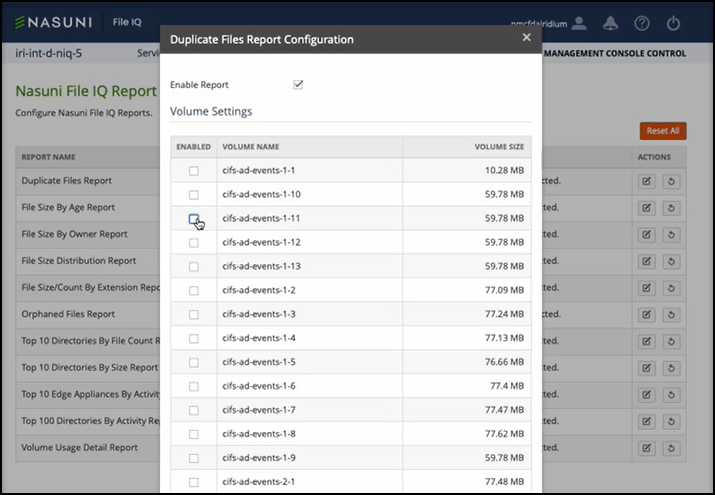
Using the table, check each of the volumes you want included in the report.
Click Save.
Disabling the Duplicate Files Report
To disable the Duplicate File report, follow these steps:
Navigate to the File IQ UI.
Click Configuration -> Reports.
Locate the Duplicate Files Report in the table and click the corresponding edit icon
.png) .
.Uncheck the Enable Report box.
Click Save.
Troubleshooting
Q: Report executes successfully, but the PDF/CSV does not contain any volume data.
A: This occurs when no volumes are selected in the Duplicate Files Report configuration modal. Select one or more volumes and re-run the report.
Q: A connected volume is not available for selection in the Duplicate Files Report configuration modal.
A: Volumes are not available for selection until they have undergone an initial metadata scan. Start or complete a scan, then return to the configuration modal.
Q: The report times out.
A: All reports are configured to time out after 24 hours. This threshold may be reached when huge volumes, or large numbers of volumes, are selected. Reduce the number of volumes chosen or omit huge volumes to ensure completion within 24 hours.
Q: The report takes a long time to process.
A: For very large volumes, execution can take a long time; we recommend running this report one volume at a time.
Q: The Reporting feature is enabled, but the report does not run on its weekly schedule.
A: By default, the report is disabled. Verify that Report Enabled is selected in the Duplicate Files Report configuration modal.
Q: A volume section shows “Volume data is unavailable…”
A: This indicates that a volume scan was still in progress and was not completed before generating the report. Allow the scan to finish and execute the report again.
Q: A volume section shows “This volume does not contain any files.”
A: This indicates that no duplicate files were found in this volume during the report generation.
Q: The report executes successfully, but no duplicate files are listed.
A: This occurs when all duplicate candidates on the selected volume(s) are smaller than the minimum assessed size. The Duplicate Files Report only assesses files ≥ 1,000,000 bytes (1 MB). This threshold is fixed and cannot be changed by the user. Select volumes that contain duplicated files ≥ 1 MB and re-run the report.
Orphaned Files Report
The Orphaned Files report lists files on CIFS volumes whose owner user cannot be resolved in Active Directory. It summarises counts and total sizes grouped by the last-known identifiers (Owner User SID/Owner Group SID), then expands each owner to show every orphaned file instance and its attributes per volume.
Note: For very large volumes, execution can take a long time; we recommend running this report one volume at a time.
The PDF format report includes the following information for each volume:
Summary: A summarised listing of files whose owner user cannot be resolved. The table contains one row per owner user or owner group (based on last-known SIDs) with the following:
Rank: Lists orphaned files in descending order by file name and creation date.
Owner User SID
Owner Group SID
Orphan Count
Total Size
Details: Each owner from the summary expands into a two-level details section with the following:
Owner Summary row, which includes the following information:
Owner User
User SID
Last-known user
Owner Group
Group SID
Last-known group
Orphan Count
Total Size
Orphaned File Instance table (one row per file instance), which includes the following information:
File Path
File Size
Create Time
Modified Time
Rows are ordered by File Name (A→Z) and then Create Time (newest first).
Note: If the Directory Service cannot resolve the CIFS owner user or owner group during the scan, the report displays the CIFS Owner User and CIFS Owner Group identifiers.
The CSV format report displays the following information for each volume:
Column Name | Description |
|---|---|
Volume Name | The volume name. |
Owner User | Owning user. |
Owner Group | Owning group. |
File Path | The absolute directory path. |
Size Bytes | Size of the instance in bytes. |
Created At | File creation timestamp. |
Modified At | File last-modified timestamp. |
Total Files | The total number of orphaned files. |
Owner User SID | Owner user SID |
Owner group SID | Owner group SID |
Running the Orphaned Files Report
To run the Orphaned Files report, follow these steps:
Navigate to the File IQ UI.
Click Reporting > Report Management.
Click the Orphaned Files Report.
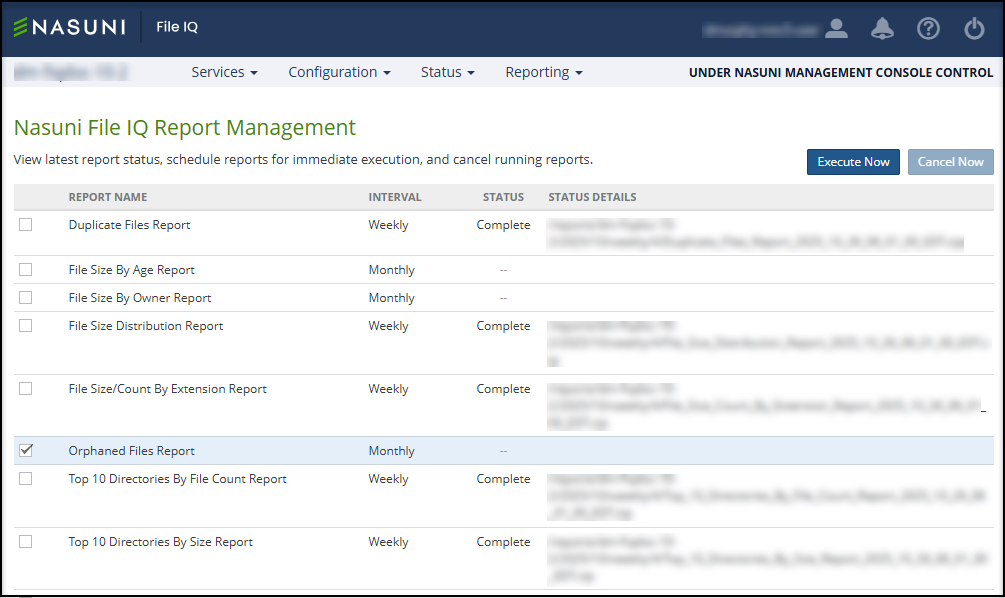
Click Execute Now.
Troubleshooting
Q: Report executes successfully, but the PDF/CSV does not contain any volume data.
A: This occurs when no volumes are selected in the Orphaned Files Report configuration modal. Select one or more volumes and re-run the report.
Q: A connected volume is not available for selection in the Orphaned Files Report configuration modal.
A: Volumes are not available for selection until they have undergone an initial metadata scan. Start or complete a scan, then return to the configuration modal.
Q: Why does the report time out?
A: All reports are configured to time out after 24 hours. This threshold might be reached when huge volumes, or large numbers of volumes, are selected. Reduce the number of volumes chosen or omit huge volumes to ensure completion within 24 hours.
Q: Why does the report take a long time to process?
A: For huge volumes, execution can take a long time; we recommend running this report one volume at a time.
Q: A volume section shows “Volume data is unavailable…”
A: This indicates that no orphaned files were found in the volume during the report generation.
Q: A volume section shows “This volume does not contain any files.”
A: This indicates that no orphaned files were found in this volume during the report generation.
Q: A connected NFS volume is not available for selection in the Orphaned Files Report configuration modal.
A: NFS volumes are intentionally hidden because the Orphaned Files Report is CIFS-only (AD-backed); select a CIFS volume or confirm the volume protocol is CIFS and that an initial metadata scan has completed.
Reset All Report Configuration
It is possible to reset all the report configurations with a single action. This is the same as clicking on the reset action for each of the reports individually and only requires a single confirmation.
To reset ALL the report configuration, follow these steps:
Navigate to the File IQ UI.
Click Configuration -> Reports.
Click Reset All.
In the Confirmation Phrase box, enter “Reset All Reports” and click Confirm. A notification dialog appears in the top right of the page confirming the save action with the text Nasuni File IQ Report Configurations reset successfully.
The configurations are reset.